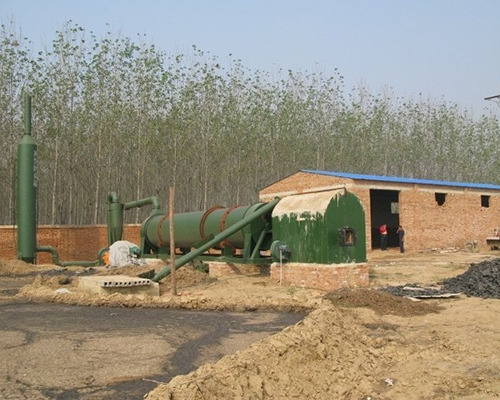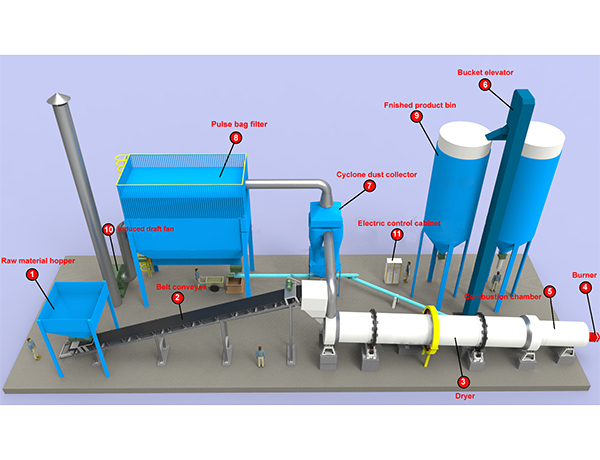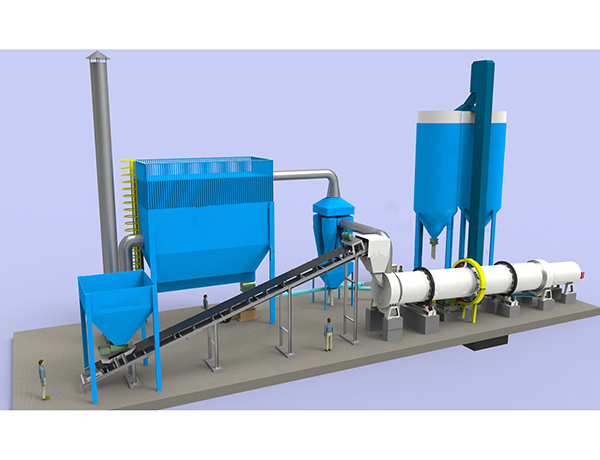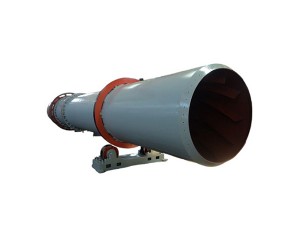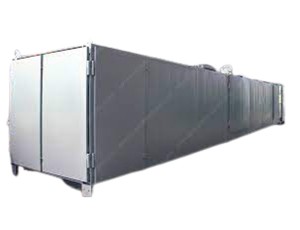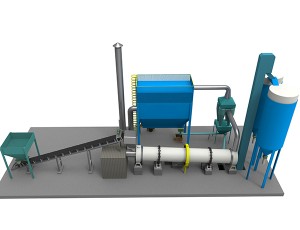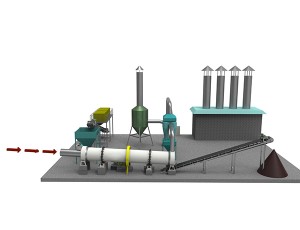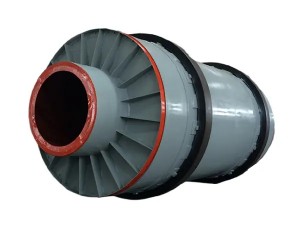

High Humidity Material Drying System
High Humidity Material Drying System
Material Description
The most traditional disposal way of the livestock manure is to sell as farmyard manure with the low price and be used directly as the agricultural fertilizer, its economic value is not to fully explored and utilized. In fact, these are the precious fodder and fertilizer resources, if it can be developed and utilized, it will have great significance to the organic fertilizer manufacturing, to the development of planting and breeding industry, to promote agricultural production and income, energy saving and pollution-free green food, green agriculture development, to environmental protection and people's health.
Process Flow
The dewatered material will be transported to feeding head of the dryer through the screw conveyor after scattering, and then it will be sent into the inside of the dryer through the unpowered spiral sealing feeder (the patent technology of our company), and going through several following working areas after getting into the dryer:
1. Material leading-in area
The material will come into contact with the high temperature negative pressure air after getting into this area and plenty of water will be rapidly evaporated, and the material can’t be formed into sticky stuff under the stirring of large guide angle lifting plate.
2. Cleaning area
The material curtain will be formed while the sludge is lifted up at this area, and it will cause the material stick on the cylinder wall while it’s falling down, and the cleaning device is installed at this area (Lifting style stirring plate, X type second time stirring plate, impacting chain, impacting plate), the material can be quickly removed from the cylinder wall by the cleaning device, and the cleaning device can also crush the materials which are bonded together, so as to increase the heat exchange area, increase the time of heat exchange, avoid the generation of wind tunnel phenomenon, improve the drying rate;
3. Inclined lifting plate area
This area is the low temperature drying area, the slime of this area is at the low moisture and loose state, and there is no adhesion phenomenon at this area, the finished products reach the moisture requirements after the heat exchange, and then enter the final discharge area;
4. Discharging area
There aren’t stirring plates at this area of the dryer cylinder, and the material will be rolling to the discharging port. The material gradually becomes loose after drying, and discharged from the discharging end, and then sent to the designated position by the conveying device, and the fine dust drawn out along with the tail gas is collected by the dust collector.
Hot air enters into the drying machine from the feeding end, and the temperature is gradually reduced at the same time of material convection heat transfer, and the water steam taken out under the suction of induced draft fan, and then emitted into the air after processing.
System Advantages
High thermal efficiency, low drying cost
New internal structure, and strengthen the cleaning of dispersed material and heat conduction, eliminate the sticking phenomenon of the barrel body’s inner wall, it’s more adaptable to the material moisture and stickiness, the heat exchanging area and the drying efficiency are increased. The operating parameters can be changed according to different materials, and the heat exchange of the material in the dryer is more fully.
Reliable running, good stability
The new type of feeding and discharging device, put an end to the phenomenon of the plug in feeding, incontinuity, nonuniform and material return. The "aligning roller device” is adopted by the dryer, which makes the tug and rolling ring always do the linear contact, and it greatly reduces the abrasion and power consumption. The “zero horizontal thrust” of the dryer is realized, which greatly reduces the abrasion of the gear wheel and supporting wheel, the cylinder operation is more stable and reliable.
Wide range of heat source using, environmental protection and non-pollution
The coal, oil, natural gas, liquefied petroleum gas can be used as fuel. It’s determined according to material requirements and local natural advantages, to improve production efficiency and economic benefits.
High level of automation, real-time security
The PLC automatic control system can be adopted in the entire system, the system contains advanced testing equipment: temperature measurement, temperature regulation (it can be adjusted at any time according to the needs of the material), the function of automatic fault alarm, automatic shutdown protection, etc.
Technical Parameters
|
Model |
Cylinder diameter(mm) |
Cylinder length(mm) |
Cylinder volume(m3) |
Cylinder rotary speed (r/min) |
Power(kW) |
Weight(t) |
|
VS 0.6x5.8 |
600 |
5800 |
1.7 |
1-8 |
3 |
2.9 |
|
VS 0.8x8 |
800 |
8000 |
4 |
1-8 |
4 |
3.5 |
|
VS 1x10 |
1000 |
10000 |
7.9 |
1-8 |
5.5 |
6.8 |
|
VS 1.2x5.8 |
1200 |
5800 |
6.8 |
1-6 |
5.5 |
6.7 |
|
VS 1.2x8 |
1200 |
8000 |
9 |
1-6 |
5.5 |
8.5 |
|
VS 1.2x10 |
1200 |
10000 |
11 |
1-6 |
7.5 |
10.7 |
|
VS 1.2x11.8 |
1200 |
11800 |
13 |
1-6 |
7.5 |
12.3 |
|
VS 1.5x8 |
1500 |
8000 |
14 |
1-5 |
11 |
14.8 |
|
VS 1.5x10 |
1500 |
10000 |
17.7 |
1-5 |
11 |
16 |
|
VS 1.5x11.8 |
1500 |
11800 |
21 |
1-5 |
15 |
17.5 |
|
VS 1.5x15 |
1500 |
15000 |
26.5 |
1-5 |
15 |
19.2 |
|
VS 1.8x10 |
1800 |
10000 |
25.5 |
1-5 |
15 |
18.1 |
|
VS 1.8x11.8 |
1800 |
11800 |
30 |
1-5 |
18.5 |
20.7 |
|
VS 1.8x15 |
1800 |
15000 |
38 |
1-5 |
18.5 |
26.3 |
|
VS 1.8x18 |
1800 |
18000 |
45.8 |
1-5 |
22 |
31.2 |
|
VS 2x11.8 |
2000 |
11800 |
37 |
1-4 |
18.5 |
28.2 |
|
VS 2x15 |
2000 |
15000 |
47 |
1-4 |
22 |
33.2 |
|
VS 2x18 |
2000 |
18000 |
56.5 |
1-4 |
22 |
39.7 |
|
VS 2x20 |
2000 |
20000 |
62.8 |
1-4 |
22 |
44.9 |
|
VS 2.2x11.8 |
2200 |
11800 |
44.8 |
1-4 |
22 |
30.5 |
|
VS 2.2x15 |
2200 |
15000 |
53 |
1-4 |
30 |
36.2 |
|
VS 2.2x18 |
2200 |
18000 |
68 |
1-4 |
30 |
43.3 |
|
VS 2.2x20 |
2200 |
20000 |
76 |
1-4 |
30 |
48.8 |
|
VS 2.4x15 |
2400 |
15000 |
68 |
1-4 |
30 |
43.7 |
|
VS 2.4x18 |
2400 |
18000 |
81 |
1-4 |
37 |
53 |
|
VS 2.4x20 |
2400 |
20000 |
91 |
1-4 |
37 |
60.5 |
|
VS 2.4x23.6 |
2400 |
23600 |
109 |
1-4 |
45 |
69.8 |
|
VS 2.8x18 |
2800 |
18000 |
111 |
1-3 |
45 |
62 |
|
VS 2.8x20 |
2800 |
20000 |
123 |
1-3 |
55 |
65 |
|
VS 2.8x23.6 |
2800 |
23600 |
148 |
1-3 |
55 |
70 |
|
VS 2.8x28 |
2800 |
28000 |
172 |
1-3 |
75 |
75 |
|
VS 3x20 |
3000 |
20000 |
141 |
1-3 |
55 |
75 |
|
VS 3x23.6 |
3000 |
23600 |
170 |
1-3 |
75 |
85 |
|
VS 3x28 |
3000 |
28000 |
198 |
1-3 |
90 |
91 |
|
VS 3.2x23.6 |
3200 |
23600 |
193 |
1-3 |
90 |
112 |
|
VS 3.2x32 |
3200 |
32000 |
257 |
1-3 |
110 |
129 |
|
VS 3.6x36 |
3600 |
36000 |
366 |
1-3 |
132 |
164 |
|
VS 3.8x36 |
3800 |
36000 |
408 |
1-3 |
160 |
187 |
|
VS 4x36 |
4000 |
36000 |
452 |
1-3 |
160 |
195 |
Working Sites’ Pics
